Abstract
Malaria is among mankind's worst scourges, affecting many millions of people, particularly in the tropics. Human malaria is caused by several species of Plasmodium, a parasitic protozoan. We analyze the small subunit rRNA gene sequences of 11 Plasmodium species, including three parasitic to humans, to infer their evolutionary relationships. Plasmodium falciparum, the most virulent of the human species, is closely related to Plasmodium reichenowi, which is parasitic to chimpanzee. The estimated time of divergence of these two Plasmodium species is consistent with the time of divergence (6-10 million years ago) between the human and chimpanzee lineages. The falciparum-reichenowi clade is only remotely related to two other human parasites, Plasmodium malariae and Plasmodium vivax, which are also only remotely related to each other. Thus, the parasitic associations of the Plasmodium species with their human hosts are phylogenetically independent. The remote phylogenetic relationship between the two bird parasites, Plasmodium gallinaceum and Plasmodium lophurae, and any of the human parasites provides no support for the hypothesis that infection by Plasmodium falciparum is a recent acquisition of humans, possibly coincident with the onset of agriculture.
Full text
PDF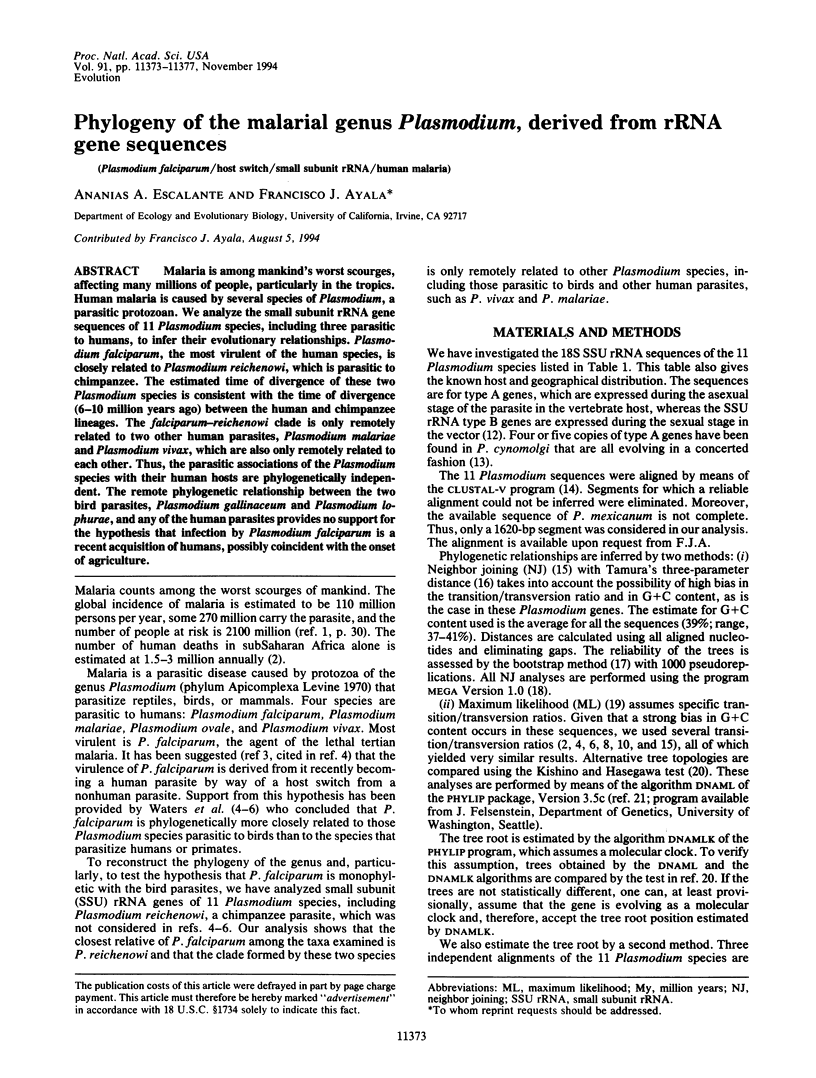
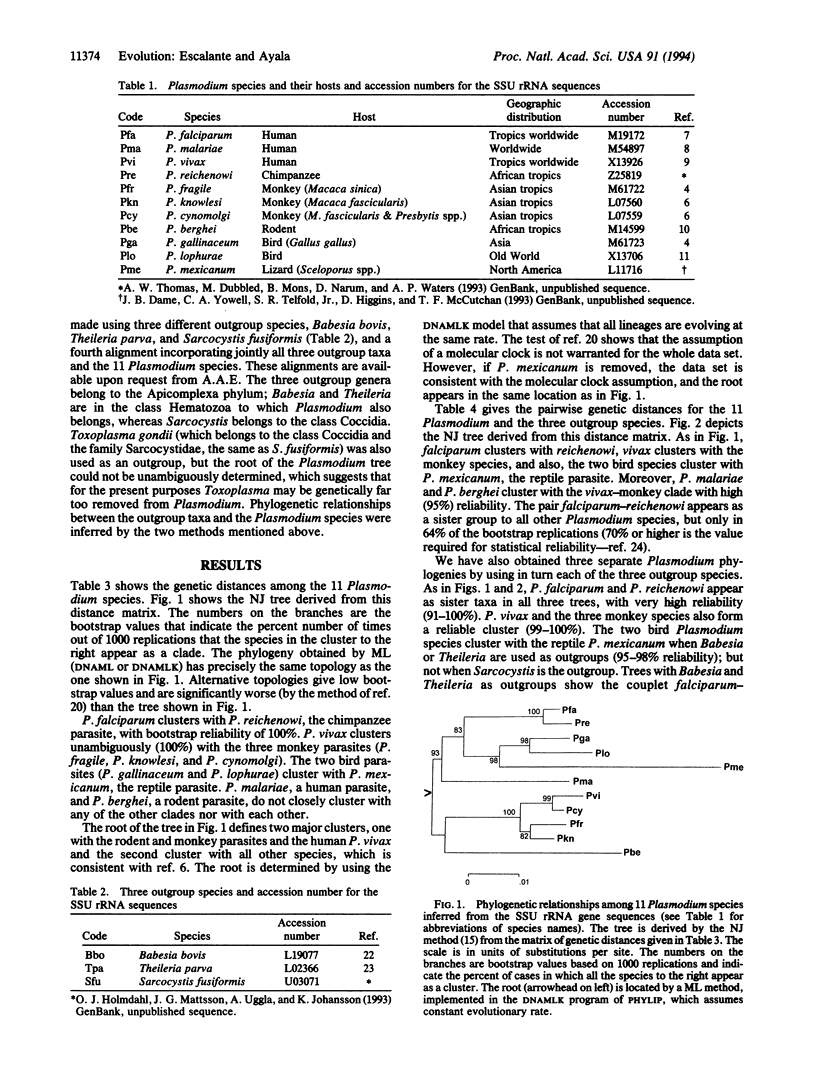
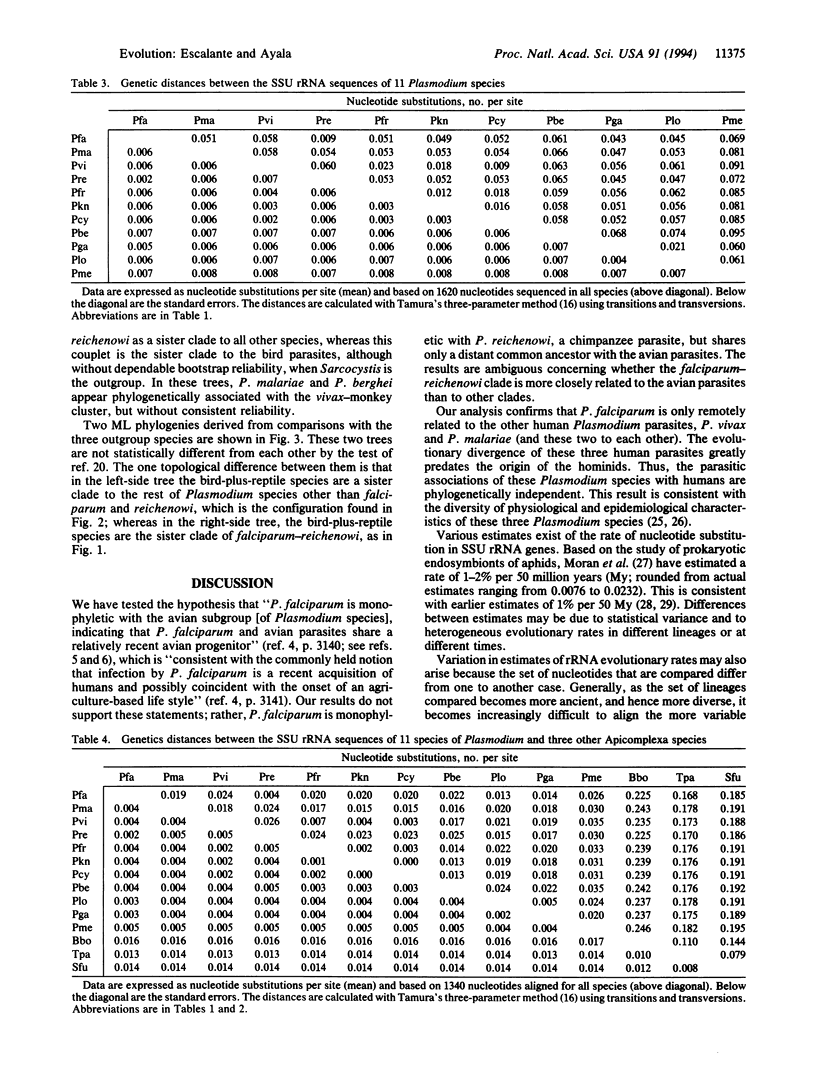
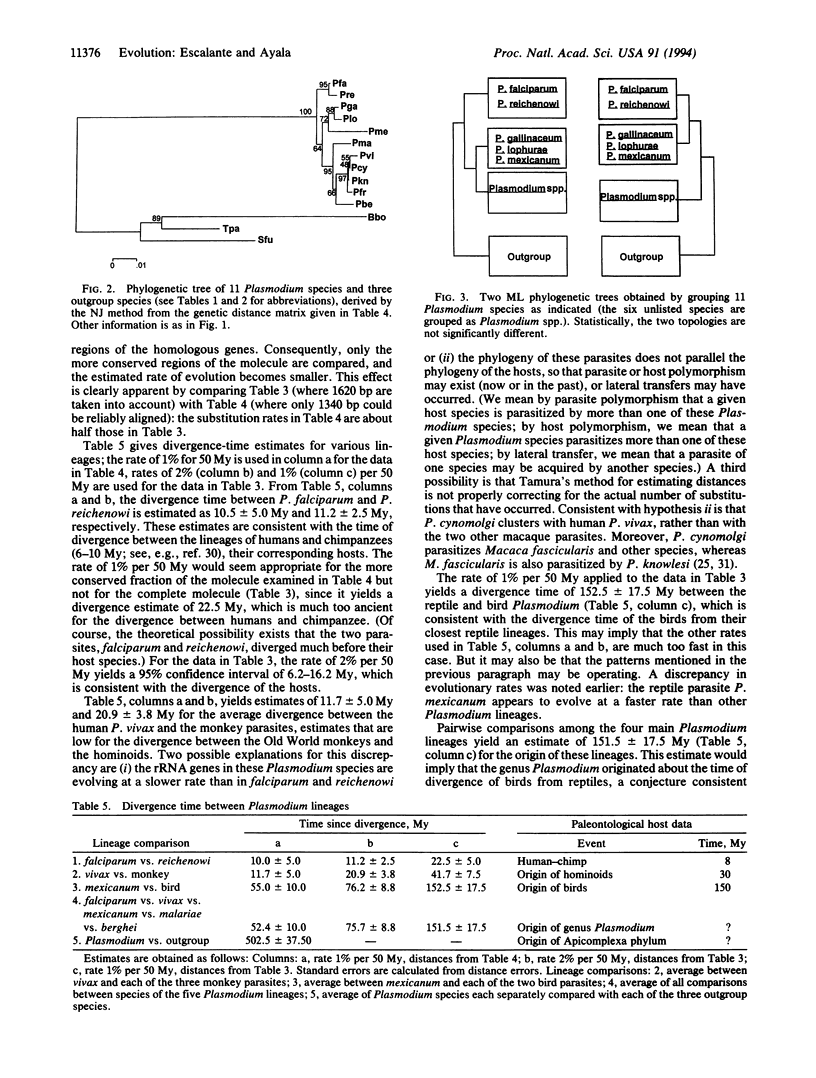
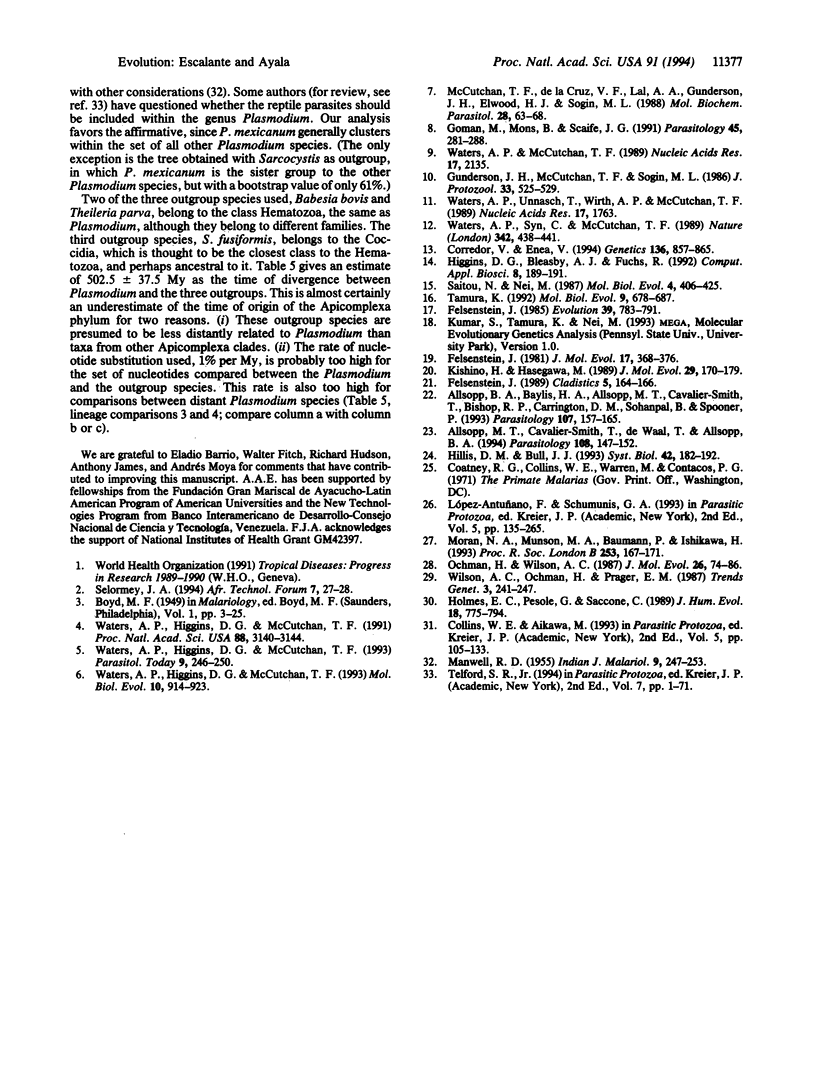
Selected References
These references are in PubMed. This may not be the complete list of references from this article.
- Allsopp B. A., Baylis H. A., Allsopp M. T., Cavalier-Smith T., Bishop R. P., Carrington D. M., Sohanpal B., Spooner P. Discrimination between six species of Theileria using oligonucleotide probes which detect small subunit ribosomal RNA sequences. Parasitology. 1993 Aug;107(Pt 2):157–165. doi: 10.1017/s0031182000067263. [DOI] [PubMed] [Google Scholar]
- Allsopp M. T., Cavalier-Smith T., De Waal D. T., Allsopp B. A. Phylogeny and evolution of the piroplasms. Parasitology. 1994 Feb;108(Pt 2):147–152. doi: 10.1017/s0031182000068232. [DOI] [PubMed] [Google Scholar]
- Corredor V., Enea V. The small ribosomal subunit RNA isoforms in Plasmodium cynomolgi. Genetics. 1994 Mar;136(3):857–865. doi: 10.1093/genetics/136.3.857. [DOI] [PMC free article] [PubMed] [Google Scholar]
- Felsenstein J. Evolutionary trees from DNA sequences: a maximum likelihood approach. J Mol Evol. 1981;17(6):368–376. doi: 10.1007/BF01734359. [DOI] [PubMed] [Google Scholar]
- Goman M., Mons B., Scaife J. The complete sequence of a Plasmodium malariae SSUrRNA gene and its comparison to other plasmodial SSUrRNA genes. Mol Biochem Parasitol. 1991 Apr;45(2):281–288. doi: 10.1016/0166-6851(91)90096-o. [DOI] [PubMed] [Google Scholar]
- Gunderson J. H., McCutchan T. F., Sogin M. L. Sequence of the small subunit ribosomal RNA gene expressed in the bloodstream stages of Plasmodium berghei: evolutionary implications. J Protozool. 1986 Nov;33(4):525–529. doi: 10.1111/j.1550-7408.1986.tb05656.x. [DOI] [PubMed] [Google Scholar]
- Higgins D. G., Bleasby A. J., Fuchs R. CLUSTAL V: improved software for multiple sequence alignment. Comput Appl Biosci. 1992 Apr;8(2):189–191. doi: 10.1093/bioinformatics/8.2.189. [DOI] [PubMed] [Google Scholar]
- Kishino H., Hasegawa M. Evaluation of the maximum likelihood estimate of the evolutionary tree topologies from DNA sequence data, and the branching order in hominoidea. J Mol Evol. 1989 Aug;29(2):170–179. doi: 10.1007/BF02100115. [DOI] [PubMed] [Google Scholar]
- MANWELL R. D. Some evolutionary possibilities in the history of the malaria parasites. Indian J Malariol. 1955 Dec;9(4):247–253. [PubMed] [Google Scholar]
- McCutchan T. F., de la Cruz V. F., Lal A. A., Gunderson J. H., Elwood H. J., Sogin M. L. Primary sequences of two small subunit ribosomal RNA genes from Plasmodium falciparum. Mol Biochem Parasitol. 1988 Feb;28(1):63–68. doi: 10.1016/0166-6851(88)90181-8. [DOI] [PubMed] [Google Scholar]
- Ochman H., Wilson A. C. Evolution in bacteria: evidence for a universal substitution rate in cellular genomes. J Mol Evol. 1987;26(1-2):74–86. doi: 10.1007/BF02111283. [DOI] [PubMed] [Google Scholar]
- Saitou N., Nei M. The neighbor-joining method: a new method for reconstructing phylogenetic trees. Mol Biol Evol. 1987 Jul;4(4):406–425. doi: 10.1093/oxfordjournals.molbev.a040454. [DOI] [PubMed] [Google Scholar]
- Tamura K. Estimation of the number of nucleotide substitutions when there are strong transition-transversion and G+C-content biases. Mol Biol Evol. 1992 Jul;9(4):678–687. doi: 10.1093/oxfordjournals.molbev.a040752. [DOI] [PubMed] [Google Scholar]
- Waters A. P., Higgins D. G., McCutchan T. F. Evolutionary relatedness of some primate models of Plasmodium. Mol Biol Evol. 1993 Jul;10(4):914–923. doi: 10.1093/oxfordjournals.molbev.a040038. [DOI] [PubMed] [Google Scholar]
- Waters A. P., Higgins D. G., McCutchan T. F. Plasmodium falciparum appears to have arisen as a result of lateral transfer between avian and human hosts. Proc Natl Acad Sci U S A. 1991 Apr 15;88(8):3140–3144. doi: 10.1073/pnas.88.8.3140. [DOI] [PMC free article] [PubMed] [Google Scholar]
- Waters A. P., Higgins D. G., McCutchan T. F. The Phylogeny of malaria: a useful study. Parasitol Today. 1993 Jul;9(7):246–250. doi: 10.1016/0169-4758(93)90066-o. [DOI] [PubMed] [Google Scholar]
- Waters A. P., McCutchan T. F. Partial sequence of the asexually expressed SU rRNA gene of Plasmodium vivax. Nucleic Acids Res. 1989 Mar 11;17(5):2135–2135. doi: 10.1093/nar/17.5.2135. [DOI] [PMC free article] [PubMed] [Google Scholar]
- Waters A. P., Syin C., McCutchan T. F. Developmental regulation of stage-specific ribosome populations in Plasmodium. Nature. 1989 Nov 23;342(6248):438–440. doi: 10.1038/342438a0. [DOI] [PubMed] [Google Scholar]
- Waters A. P., Unnasch T. R., Wirth D. F., McCutchan T. F. Sequence of a small ribosomal RNA gene from Plasmodium lophurae. Nucleic Acids Res. 1989 Feb 25;17(4):1763–1763. doi: 10.1093/nar/17.4.1763. [DOI] [PMC free article] [PubMed] [Google Scholar]


